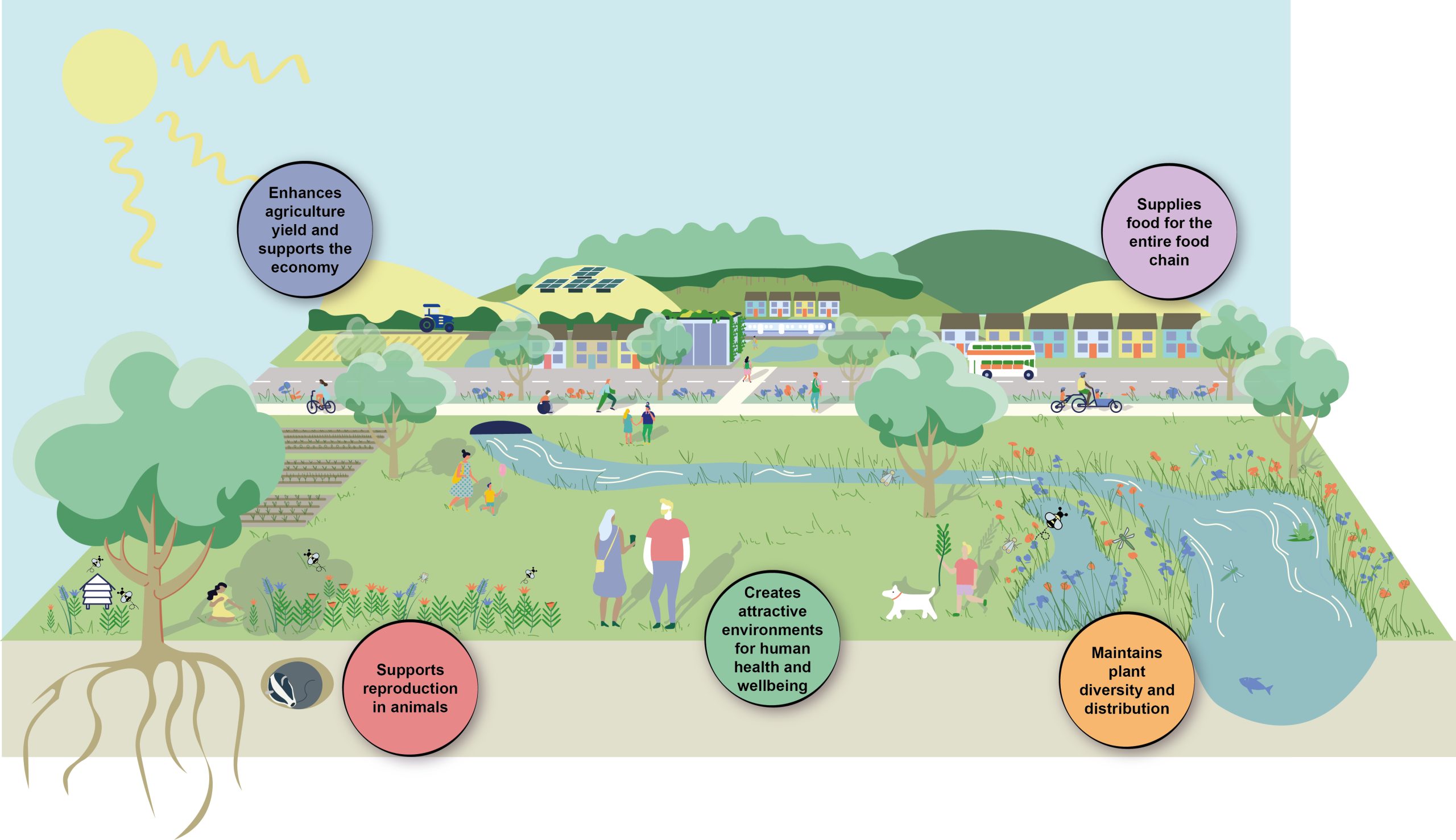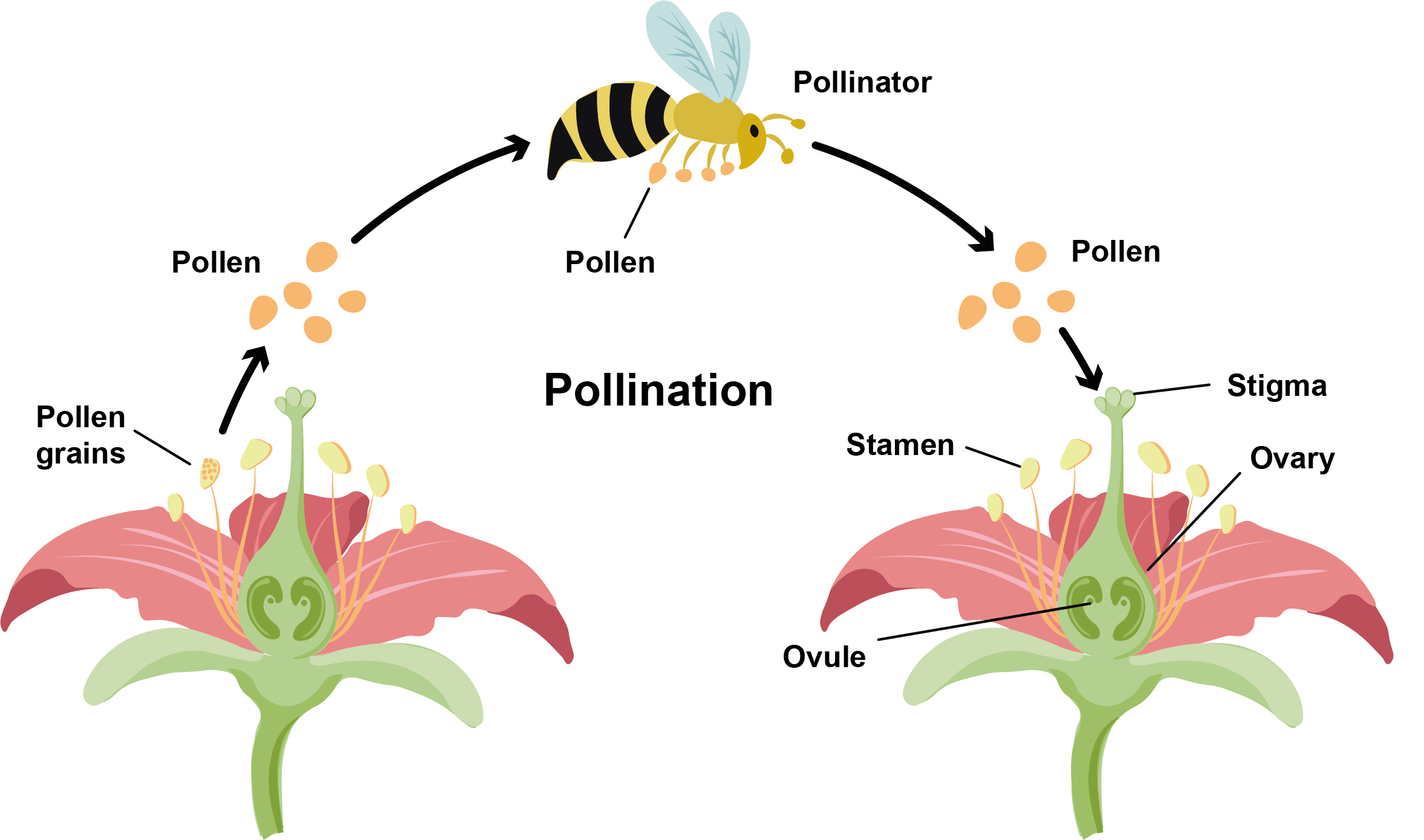Page Contents:
Flagship pollinators in Pembrokeshire
Linking with wider initiatives
Purpose of the pollinator strategies
Structure of the pollinator strategies
Pollinator Strategies
The importance of pollinators
5.1 Pollinators are an essential part of our environment. They include species such as honey bees, bumblebees, solitary bees, parasitic wasps, hover flies, butterflies, moth and some species of flies and beetles.
5.2 Pollinators increase the diversity of wildflower species, contributing to enhanced biodiversity and improved ecological resilience. They are of intrinsic value in their own right as part of our natural heritage, and some, such as bees and butterflies, are widely appreciated by the public.
5.3 These species are important as they provide food security for many types of crops and nitrogen fixing plants that are important in improving productivity of pastures for livestock grazing. The value of pollination [See reference [1]] to agriculture in the UK was estimated at £690 million. Pollinators therefore make our food bills much lower than they would be if we had to hand pollinate crops. The value of honey [See reference [2]] produced in Wales alone is also considerable with a wholesale value in excess of £2 million in 2011.
Figure 5.1: Benefits of Pollinators

5.4 Pollinators are relatively easy to provide for as long as the plants they need at various stages of their life cycle are preserved or retained. Pollinators require food in the form of pollen and nectar foraged from a variety of flowering plant species; and diverse vegetation structure, e.g. hedgerows, scrub and tall grass for shelter, nesting and overwintering such as burrows and holes in tree trunks. In order to support a variety of pollinator species, nectar sources need to be available from early spring through to late autumn.
Figure 5.2: Pollination
Policy context
National
5.5 Well-being of Future Generations (Wales) Act 2015 (Opens in new window) recognises the importance that the Welsh Government places on our nature and its biodiversity. Along with six other goals, the Act puts in place the ‘Resilient Wales’ goal: ‘A nation which maintains and enhances a biodiverse natural environment with healthy functioning ecosystems that support social, economic and ecological resilience and the capacity to adapt to change (for example climate change).’ All public bodies in Wales will have to work towards this and all of the goals as required under the Act, adopting the principles outlined in the Act.
5.6 Central to the Environment (Wales) Act 2016 (Opens in new window) puts in place a new more integrated approach to managing our natural resources in order to achieve long-term sustainability. Actions for pollinators are delivered through the State of Natural Resources Report (Opens in new window) , a National Natural Resources Policy (Opens in new window) and Area Statements (Opens in new window).
5.7 The Nature Recovery Plan for Wales (2015) (Opens in new window), sets out Welsh Government’s commitment to biodiversity in Wales. It includes objectives for safeguarding species and habitats of principal importance and improving their management and tackling key pressures on species and habitats.
5.8 The Action Plan for Pollinators in Wales (Opens in new window) details a Vision for Pollinators in Wales, and puts that into the context of the Welsh Government’s priorities and policies. It also lays out an Agenda for Action – the outcomes and areas for action that have been identified and how we will work towards them.
Regional
5.9 The South West Wales Area Statement (Opens in new window) identifies the key risks, opportunities and priorities that we all need to address to build the resilience of our ecosystems and support sustainable management of the natural resources. Opportunities identified include targeting the planting of native species and connecting nearby habitats such as grasslands, where species and thrive and spread.
Local
5.10 The Pembrokeshire Local Biodiversity Action Plan (Opens in new window) includes information and action plans on the priority habitats and species in Pembrokeshire. It includes visions to maintain and enhance the number and distribution of Marsh Fritillaries and Brown Hairstreak butterflies in Pembrokeshire – two of the county’s most notable pollinator species.
Back to top
Key threats
5.11 There is widespread concern over the status of pollinators, as many insect groups including bees, butterflies, moths and hoverflies have declined dramatically in the UK and globally both in their abundance and diversity. The loss of meadow habitat in Britain has led to half of the 27 species of bumble bee to decline [See reference [3]], with three already being extinct. Approximately two thirds of moths are in long term decline and over 70% of butterflies are declining.
5.12 The key threats facing pollinators include habitat loss, climate change and the use of pesticides.
5.13 Habitat loss, notably decline in wildflower rich grasslands, is the most significant cause of pollinator decline. Wales has lost 97 percent [See reference [4]] of its wildflower meadows since the 1930s.
5.14 Increased use of pesticides has resulted in a major impact on pollinators and the plants on which they depend. The use of neonicotinoid pesticides are of particular concern with research [See reference [5]] showing that even minute traces of these toxic chemicals in crop pollen or wildflowers play havoc with the ability of bees to navigate, with catastrophic consequences for the survival of their colony. Herbicides do not directly harm pollinators, but their excessive use can diminish the supply of flowering plants on which they depend.
5.15 The disruption of seasonal patterns and shifting of flowering periods due to climate change can deprive pollinators of critical food supplies. This is especially true for specialist species who depend on only a few plants. Climate change is predicted to decrease bee species richness by eight to 18 percent [See reference [6]] in some areas and it is also known that the geographic range of bumbles is shrinking as their synchrony between flowering plants and their pollinators is being disrupted.
Back to top
Flagship pollinators in Pembrokeshire
5.16 In Wales, 1500 [See reference [7]] species of insect are pollinators. Outlined below are some of the nationally rare and threatened species of pollinators found in Pembrokeshire.
Bees
5.17 The decline of a range of pollinator species more previously widespread in Wales has been well reported. Typically inland populations of, for example, Shrill Carder Bee, Brown-banded Bee and the Longhorn Bee [See reference [8]] have been lost because remaining areas of lowland semi-natural habitats tend to be small, fragmented and poorly connected, confining remaining populations to coastal habitats. In Wales at least 64 species of bee are in decline. The Pembrokeshire Coast National Park is considered one of the most significant areas for bees in Wales.
Butterflies
5.18 Butterflies are undergoing a serious, long-term and ongoing decline in the UK. The overall pattern suggests 76% of the UK’s resident and migrant butterflies have declined in either abundance or occurrence (or both) over the past four decades [See reference [9]]. In Wales there have been significant decreases in abundance for habitat specialists according to UK Butterfly Monitoring Scheme [See reference [10]].
Moths
5.19 Moths are also important contributors to pollination. In Wales there are over 1700 moths [See reference [11]] as well as many migrant species. However, there has been a significant decline in abundance and range of moths.
5.20 In Pembrokeshire, the majority of moth populations are stable although they should still be conserved for their contribution towards pollination. Species of moth found within Pembrokeshire include the six-spot burnet, narrow-bordered five spot burnet, five spot burnet, mint moth, oak egger, eye hawk moth, poplar hawk moth, flame carpet, barred red, puss moth, ruby tiger, cinnabar, red-necked footman, red underwing and flame shoulder moth.
Hoverflies
5.21 Hoverflies have seen a decline across the UK as shown from various data recording schemes. Hoverflies feed exclusively on nectar and pollen which makes them important pollinators. They are able to travel greater distances [See reference [12]]than many other pollinator species which adds to their significance within fragmented habitats. Species found in Wales include the marmalade fly, common banded hoverfly, drone-fly and the hornet mimic hoverfly.
Back to top
Linking with wider initiatives
Bee Friendly Initiative
5.22 Bee Friendly (Opens in new window) is the Action Plan for Pollinators Task Force’s scheme to encourage organisations and communities throughout Wales to take action to help pollinators. All pollinators are included: honey bees, bumble bees and solitary bees, some wasps, butterflies, moths and hoverflies, and some beetles and flies.
5.23 The Four Goals for Bee Friendly are:
- Food – providing pollinator-friendly food sources in your area;
- Five Star accommodation – providing places for insect pollinators to live;
- Freedom from pesticides and herbicides – committing to avoid chemicals that harm pollinators; and
- Fun – involving all the community and telling people why you are helping pollinators.
National Monitoring Schemes
5.24 Keeping track of progress of the 11 settlement pollinator strategies are fundamental in sharing and promoting success and learning from potential mistakes. Where relevant, information should be communicated to wildlife organisations or recorded systems. Suggested recording schemes and relevant projects are bullet pointed below.
- UK Pollinator Monitoring Scheme (Opens in new window);
- UK Butterfly Monitoring Scheme (Opens in new window);
- BeeWalk (Opens in new window);
- Get Britain Buzzing (Opens in new window);
- Urban Buzz (Opens in new window);
- The Great British Bee Count (Opens in new window);
- Big Butterfly Count (Opens in new window);
- National Moth Night (Opens in new window);
- Obsidentify (Opens in new window);
- Seek by iNaturalist (Opens in new window); and
- iRecord (Opens in new window).
Purpose of the pollinator strategies
5.25 The Pollinator Strategies for the 11 settlements all have the same underlying purpose. This is to:
- Outline priority actions that will create, maintain, enhance and connect pollinator habitat;
- Increase the abundance and diversity of pollinator species in the long term;
- Contribute to a thriving and resilient Pembrokeshire-wide pollinator network;
- Describe appropriate actions and methods for management and monitoring; and
- Identify potential delivery partners.
Structure of the pollinator strategies
5.26 The Pollinator Strategies are divided into three sections:
Overarching pollinator strategies
5.27 The overarching pollinator principles are intended to guide the design and delivery of the pollinator projects identified in the Settlement Management Plans as well as new pollinator projects in the future.
Pollinator Trails
5.28 Pollinator Trails have been produced for the individual 11 settlements. These include a map showing:
- Key existing pollinator assets;
- Strategic pollinator corridors; and
- Key projects.
5.29 The key projects can be cross referenced between the Settlement Management Plans for each settlement. Some of these are included as the ‘kick starter’ projects for each settlement.
Delivery
5.30 The delivery section is applicable to all settlements. It outlines the types of factors to consider when managing and maintaining the different types of pollinator-related actions that are included in the Settlement Management Plans.
Back to top
Next Chapter:
Overarching Pollinator Principles
Return to homepage:
Homepage
References
[1] Natural Resources Wales – Love Pollinators (Opens in new window)
[2] Welsh Government Action Plan for Pollinators in Wales (PDF) (Opens in new window)
[3] Wales Threatened Bee Report (Opens in new window)
[4] Plantlife – Magnificent Meadows (Opens in new window)
[5] Wildlife Trusts Wales – UK Government Puts Bees at Risk (Opens in new window)
[6] University of Bristol – What are the effects of climate change on pollinators and human health? (Opens in new window)
[7] People, Paths & Pollinators (Opens in new window)
[8] Wales Threatened Bee Report (Opens in new window)
[9] The State of the UK’s Butterflies 2015 (Opens in new window)
[10] UK Butterfly Monitoring Scheme (Opens in new window)
[11] Wales Biodiversity Partnership – Butterflies and Moths (Opens in new window)
[12] Pollination by hoverflies in the Anthropocene (Opens in new window).
